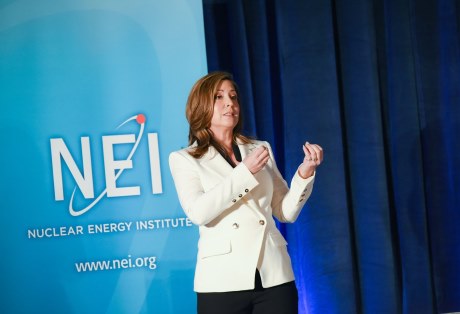Korsnick: nuclear provides 'critical infrastructure'
10 February 2017
US policymakers understand the potential impact of losing nuclear plants and states are increasingly recognising the benefits of nuclear power to consumers, the economy and the environment, Nuclear Energy Institute (NEI) CEO Maria Korsnick said yesterday at its annual briefing to Wall Street analysts.
 |
| NEI CEO Maria Korsnick addresses Wall Street analysts in New York (Image: NEI) |
Nuclear power is the "backbone" of the USA's electricity system, providing sustained economic benefits, assuring grid reliability and supplying the country's largest source of low-carbon energy, Korsnick said. The US nuclear fleet provides about 475,000 jobs and produces more than $12 billion annually in federal and state tax revenues, she added.
Korsnick identified two challenges of immediate concern to the US nuclear industry: preserving its existing nuclear fleet, and creating policy conditions under which companies will build and develop new nuclear capacity.
Future grid
"The grid of the future will include a growing role for intermittent renewable energy. So the nuclear reactors of the future will accommodate that reality. Some will make electricity around the clock. Others will produce electricity when it's needed, then produce other products when it is not. Some will supply the transportation market. Nuclear electricity will charge batteries and nuclear process heat will make alternative fuels. Some reactors will make fresh water. Some will drive industrial production. Some reactors might even produce energy from today's used fuel, reducing the disposal burden," she said.
The country's existing nuclear power plants need to be preserved so that the knowledge and expertise developed in support of today's fleet will assist the development of new reactor technologies, she said.
"We see this now. We have four reactors under construction in Georgia and South Carolina. These designs use passive safety approaches to advance the state of the art in nuclear technology. This approach was informed by decades of operational experience and innovation," Korsnick said. In addition, combined construction and operating licences for seven additional reactors have been issued by the US Nuclear Regulatory Commission, with three more currently being evaluated, providing "valuable options" for future development.
Small modular reactors (SMRs) - expected to be deployed in the early to mid-2020s - would maximise safety and inform the configuration of nuclear plants, offering flexibility in deployment and operation, she added.
Tipping point
Allowing existing nuclear plants to close prematurely would compromise the country's ability to develop a sustainable power industry, Korsnick said. Premature closures would cause significant economic damage, with the loss of expertise and the erosion of commercial infrastructure, which would limit development of the grid. The challenges of low growth in electricity demand, low natural gas prices, state and federal policies to promote renewables, transmission constraints, and other factors have led to the premature closure of several plants in recent years while others remain at risk.
"We are reaching a tipping point as policymakers have come to appreciate the risk of losing nuclear plants," she said. "However, I believe the tide is turning. The federal government, the regional transmission organisations and the states now recognise the problem, and are moving to reform the competitive markets where the greatest threats exist."
The Federal Energy Regulatory Commission has taken action to support capacity and energy market reform, and some regional transmission organisations have identified energy market challenges created by federal and state policies. The states of New York and Illinois have taken steps to preserve their nuclear generation, serving as examples to other states that effective solutions are possible, even in competitive markets, she said. The NEI has supported and worked with power companies, business, labour and advocacy groups in the pursuit of New York's Clean Energy Standard and the passage of Illinois' Future Energy Jobs Bill, she added.
Legislative or policy changes to support the continued operation of the nuclear fleet are likely to emerge in Connecticut, New Jersey, Ohio and Pennsylvania, she said. The best solutions would need to reflect the individual needs and opportunities of each state and region, she added.
"We are painfully aware of the serious challenges facing us. The forces that are putting pressure on the competitive generation sector are taking their toll on the nuclear fleet. But 2016 is also when we began to see the ocean liner change its bearing. We see states, regions and the federal government taking actions to preserve our nuclear power plants. The industry was able to work with stakeholders to preserve five nuclear plants that would have otherwise shut down. We will continue working to find policy solutions that allow these plants to remain part of our electric infrastructure."
Critical infrastructure
Nuclear energy would serve the country's priorities to improve infrastructure and create jobs, she said, adding that financial support - such as the federal loan guarantee program introduced in 2005 - would be essential to support the "relatively small companies" taking on the large capital investments associated with building a new reactor.
Chinese and Russian designs "are ahead" with global nuclear construction projects, she said, while the USA has failed to view the nuclear industry strategically.
"Although US nuclear technology suppliers still have the most advanced, most innovative and safest technologies, they start at a disadvantage, competing against sovereign entities around the world," she said.
"To preserve its ability to shape global use of nuclear technology, the US must have both a strong domestic nuclear power program and an aggressive nuclear trade and export program. The US will not be seen as a credible global nuclear leader if it casually allows its nuclear fleet to atrophy. All of this begins with strong nuclear energy infrastructure at home."
Researched and written
by World Nuclear News